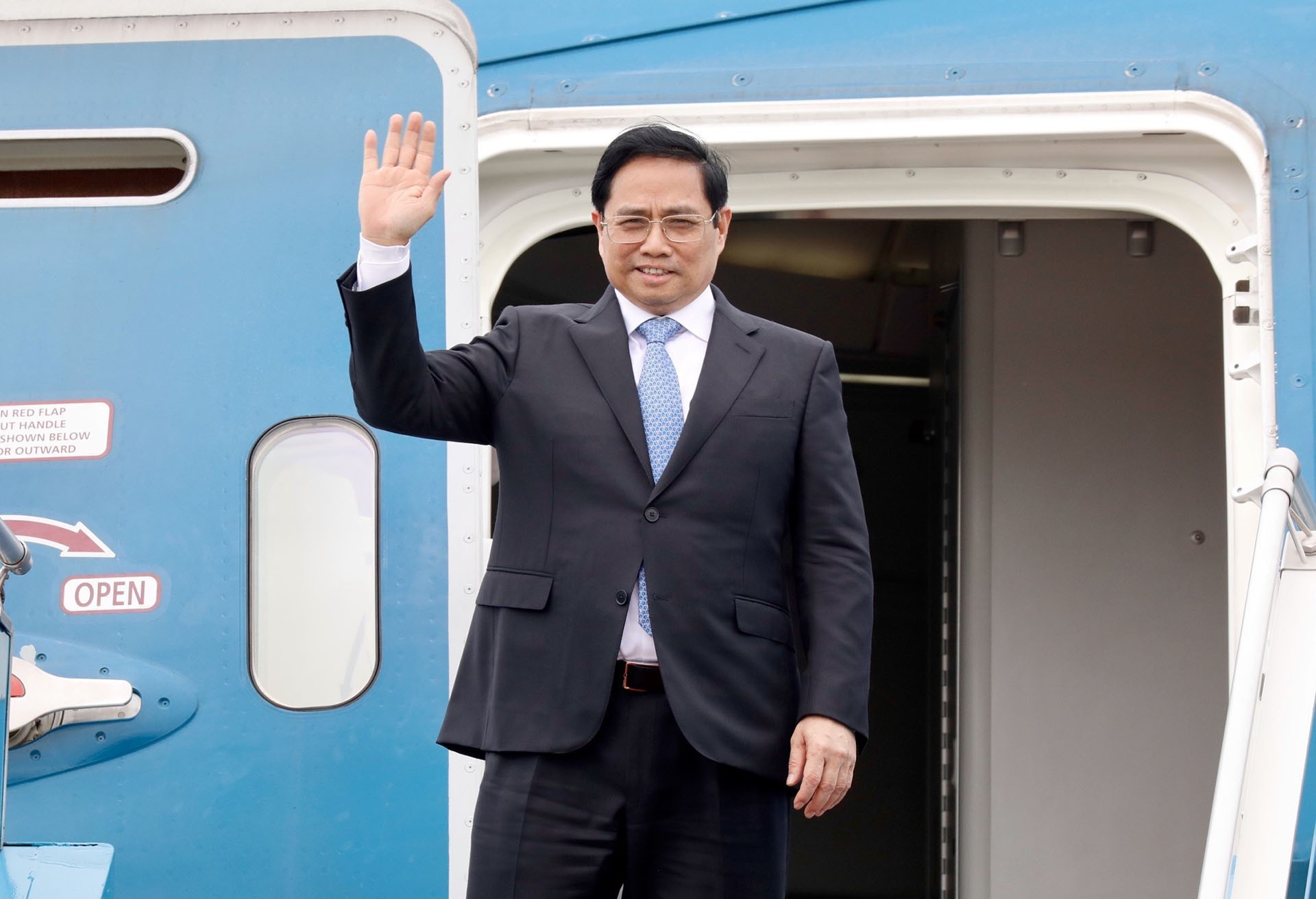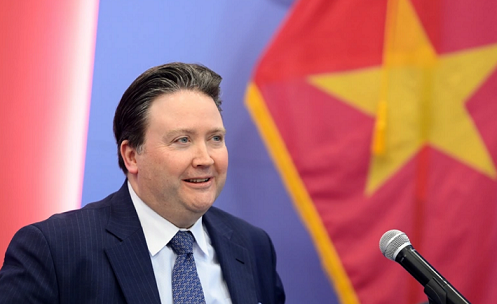
Ambassador Marc E. Knapper: The US-Viet Nam partnership has never been better
Latest
 |
| Prime Minister Pham Minh Chinh will attend a special ASEAN-US summit, visit the US and the United Nations. (Source: TTXVN) |
Prime Minister Pham Minh Chinh and other ASEAN leaders will attend the ASEAN-US Special Summit marking the 45th anniversary of the establishment of diplomatic relations between the two sides in Washington D.C. on May 12-13. A delegation of Viet Nam led by Prime Minister Chinh will also visit the US and the United Nations from May 11 to 17.
On this occasion, US Ambassador to Viet Nam Marc E. Knapper shared the key focuses of events and prospects for the US-Viet Nam relationship.
Prime Minister Pham Minh Chinh will lead a Vietnamese high-level delegation to attend the ASEAN-US Special Summit and pay a visit to the US and the United Nations (UN). Could you share the significance of the visit?
We are pleased Prime Minister Pham Minh Chinh is coming to the United States for the US-ASEAN Special Summit and welcome Prime Minister and his delegation for meetings with the US government, business, and academia.
The momentum of our bilateral relationship has been furthered by the frequent exchange of several leader-level visits, which include: General Secretary of the Communist Party Nguyen Phu Trong’s visit to the White House in 2015; President Barack Obama’s visit to Viet Nam in 2016; Prime Minister Nguyen Xuan Phuc’s visit to Washington D.C. in 2017; President Donald Trump’s visits to Ha Noi in 2017 and 2019; and Vice President Kamala Harris’ visit to Ha Noi last year.
| "Prime Minister's delegation's busy schedule for this visit represents the importance to both countries of the US-Viet Nam relationship, including in the healthcare, education, security and defense, trade, and development sectors". |
Through the historic US-ASEAN Special Summit – the first ever to be hosted in Washington – we are also demonstrating ASEAN’s importance to the United States. We seek a strong and independent ASEAN that leads in Southeast Asia. We endorse ASEAN centrality and support ASEAN in its efforts to deliver sustainable solutions to the region’s most pressing challenges.
To that end, we will deepen our long-standing cooperation with ASEAN while launching new high-level engagements on health, climate and environment, energy, transportation, and gender equity and equality. The United States remains the number-one investment partner in ASEAN member countries - investing more than Southeast Asia’s next three investment partners combined.
In your opinion, what is the important driving force for the relations between Viet Nam and the United States at the moment?
Our partnership is strong, and the breadth and depth of cooperation between our two great countries is making our partnership even stronger. In areas as diverse as trade, development, education, healthcare, energy, and security, the United States and a strong and independent Viet Nam are working together with a shared commitment to peace and prosperity.
Together, we are building strong health systems that serve the needs of our two people today and will be resilient against the health threats of tomorrow. Together, we are establishing strong connections through exchange programs that create deep people-to-people ties between US and Vietnamese students and professionals.
Together, we are building resilience to adapt to the impacts of climate change and reach our shared net-zero emissions goals.
 |
| US Ambassador to Viet Nam Marc E. Knapper. (Photo: DT) |
Together, we are building prosperity for the people of both Viet Nam and the United States. With $113 billion in bilateral trade, $2.8 billion of U.S. investment in Viet Nam's economy, increased Vietnamese investment in the US economy, US technical assistance in improving the Vietnamese economy’s competitiveness and business environment, and our cooperation to promote free, fair, and open trade, our two economies are increasingly interconnected. Our prosperity is your prosperity.
Our relationship is grounded in mutual respect for each other’s political systems, shared respect for international law, and the mutual understanding that a free and open Indo-Pacific serves the interests of not just the United States and Viet Nam, but the entire region.
Together, we are building a brighter future for the people of both countries. We have shown just how strong our comprehensive partnership is, and as we look forward to that bright future, we believe it’s time to take our relationship to the strategic partner level.
The Viet Nam-US cooperation is not limited to bilateral issues, but is expanding to regional and global issues as well as in addressing major world issues. Could you tell us more about this?
Viet Nam is a major player on the world stage, as evidenced by its successful two-year term on the UN Security Council that just ended. We work with Viet Nam on a host of issues related to our shared goals of regional and global peace and prosperity.
Our support for Viet Nam’s deployments to UN peacekeeping missions is one area that especially comes to mind. We are proud of our work with the Viet Nam Peacekeeping Center to help provide equipment, training, and exchange expertise with Vietnamese peacekeepers.
We are also a proud partner of Viet Nam within ASEAN. The United States welcomes a strong and independent ASEAN that leads in Southeast Asia. We endorse ASEAN centrality and support ASEAN in its efforts to deliver sustainable solutions to the region’s most pressing challenges.
To that end, we will deepen long-standing cooperation with ASEAN while launching new high-level engagements on health, climate and environment, energy, transportation, and gender equity and equality. We will work with ASEAN to build its resilience as a leading regional institution.
The United States is working closely with Viet Nam as we develop our vision of the Indo-Pacific Economic Framework, which seeks to advance resilience, inclusiveness, and competitiveness for our economies. Through this initiative, we aim to contribute to cooperation, peace, stability, prosperity, and sustainable development of the region. We also hope to learn from Viet Nam’s previous experience as the United States hosts APEC in 2023.
How do you assess the prospects and opportunities to elevate the relationship between Viet Nam and the United States in the coming time?
The US-Viet Nam partnership has never been better and, as the Prime Minister Pham Minh Chinh has said, Viet Nam has never enjoyed higher international prestige.
Our two countries have moved from a history of conflict and division to a Comprehensive Partnership that spans political, security, economic, and people-to-people ties, as well as efforts to address the legacies of war.
It is a partnership that is strengthening each day, and we sincerely hope to upgrade it to a Strategic Partnership. We believe that “strategic” more accurately describes the work we are already doing together. Our Indo-Pacific Strategy makes clear that this partnership and Viet Nam are central to our engagement in this vital region.
| "We believe that “strategic” more accurately describes the work we are already doing together. Our Indo-Pacific Strategy makes clear that this partnership and Viet Nam are central to our engagement in this vital region". |
With respect to economic and business relations, this is an important moment for the United States and Viet Nam, and the trade relationship between our two countries is one of our most consequential ones. Despite COVID-19, the US-Viet Nam bilateral trade hit nearly $113 billion in 2021, a 26% increase over 2020. The US and Vietnamese companies have invested, and continue to invest, billions of dollars with each other in critical sectors that impact people’s lives, such as healthcare, energy, technology, and infrastructure.
We have been a strong partner for Viet Nam throughout the COVID-19 pandemic, and we will continue to work together to lay the foundations for Viet Nam’s economic recovery.
We have provided nearly 40 million doses of vaccine, and our companies have facilitated procurements of thousands of new ventilators. We are very proud of these efforts to save lives not just in cities, but in far-reaching rural towns and provinces. And while we have witnessed the pandemic disrupt global supply chains and shipping, causing difficulties for many of our companies and both our economies, our partnership helps to guide us through pandemic recovery efforts to better days ahead.
As we heard from Special Presidential Envoy, John Kerry during his February visit to Viet Nam, the 2020s will be the decade for climate action, and no region of the world has a more pivotal role in realizing the global goal of net-zero emissions by 2050 than the economies of the East Asia Pacific region.
We see tremendous opportunities for the role of the private sector – both U.S. and Vietnamese businesses – to support climate action through innovation and investments. The United States is your steadfast partner in these efforts, which will continue for not years, but for decades to come.
Another promising area for bilateral cooperation is the digital economy, which is increasingly a key area for economic growth.
Over the past two years e-commerce, virtual meetings, and digital payments have kept our economies afloat during an unprecedented global pandemic. The digital economy accounted for an estimated 5% of Viet Nam’s GDP in 2020, and the “National Digital Transformation Program” has set a goal to increase this share to 30% of GDP by 2030.
The United States wants to see Viet Nam take its place as a leader in the digital economy, but it’s important to get the underlying structures right. We have had many productive conversations on this topic and are happy to continue to share our experiences with balancing the opportunity for growth and innovation with the need for privacy and security.
As we look to the year ahead, I see tremendous opportunities for us to deepen and expand collaboration between the U.S. Mission, the Government of Viet Nam, and our respective private sectors to support our mutual goals in Viet Nam: rebuilding global supply chains; accelerating the country’s clean energy transition and sustainable growth; developing the digital economy in line with global best practices, and bringing world-class U.S. products and services to Viet Nam to support its economic development.












